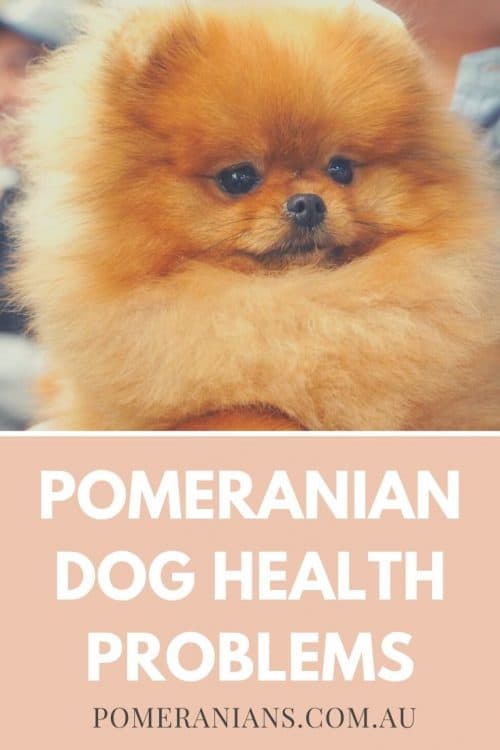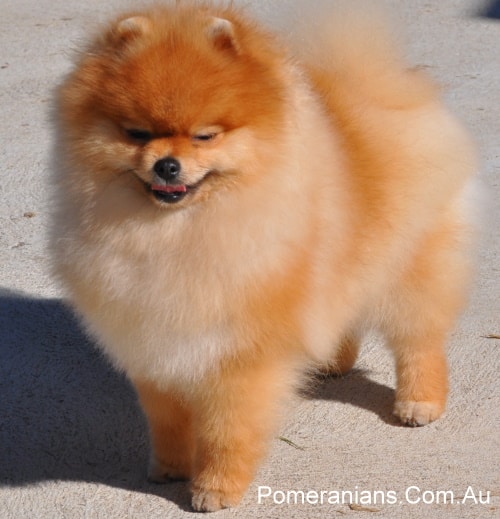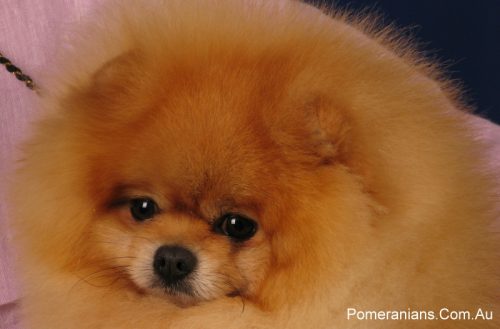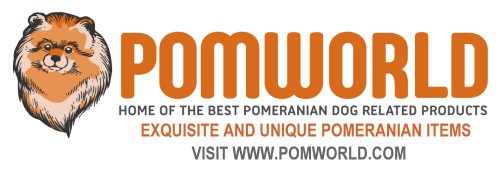Last Updated on January 25, 2021 by Denise Leo
What Health Problems Do Pomeranians Have?
It is important to understand all dogs may experience health issues common to their breeds, including x breed dogs. In the case of Pom dogs, the following are Pomeranian common health problems.
Luxating Patella Pomeranian
Though the term “luxating patella Pomeranian” may sound confusing, it simply means a knee cap that has slipped out of place.
Luxating patellas are common in Pomeranians, and Pomeranians’ knees are actually graded by the Orthopedic Foundation for Animals (OFA):
- Normal knees – Grades One and Two
- Knees requiring surgery – Grades Three and Four
If your puppy has a higher grade early in life, he or she will be more likely to need surgery, which can be expensive. (Your breeder should have this information on the patellas of your Pomeranian’s parents.)
Hypothyroidism in Pomeranians
A low-level thyroid, or hypothyroidism, is at times seen in Pomeranians.
Alopecia X Pomeranian
Pomeranians sometimes experience a coat problem called severe hair loss syndrome. This coat loss may also be referred to as black skin disease or alopecia X.
Severe hair loss syndrome Pomeranian puppies with beautiful, full, fluffy coats as puppies may develop early onset BSD. Pomeranian puppies with these types of coats often lack the harsh guard hairs and feel like “cotton” to touch.
These puppies often do not shed puppy coat and go through the ugly stage like the majority of Pomeranian puppies. Coat loss usually occurs at around 14 to 16 months and these cases are referred to as the early onset version of black skin disease.
Late onset severe hair loss syndrome usually occurs at around 3 to 4 years of age, but cases have been documented, where the Pom has developed alopecia x Pomeranian as late as 9 years of age.
Because severe hair Loss Syndrome is thought to be genetic, you should ask your breeder for information regarding this condition.
Pomeranian Health Problems Collapsing Trachea
Pomeranians who make honking noises or cough-like sounds (much like a cat regurgitating a hairball) may have collapsed tracheas.
An x-ray can diagnose the issue, and medication can reduce the symptoms. A collapsed trachea can be deadly, immediate veterinarian treatment is required.

Any coughing should be investigated and could also indicate worms, heart disease or hairballs. Pomeranian puppies have been known to die from hairballs. Fur can be ingested by the puppy while sucking the mother.
Pomeranian Reverse Sneezing (Pharyngeal Gag Reflex)
Reverse sneezing in Pomeranians happens when a dog has a rapid, sudden, forceful inhalation of air via his nose. This causes him to make numerous repeated snorts that can sound similar to choking. It’s like he’s attempting to inhale a sneeze; hence the nickname “Pomeranian reverse sneeze”).
Your Pomeranian dog may do this because he has an irritated larynx or palate area and it can cause muscular spasms in the pharynx. When your Pom does a Pomeranian reverse sneeze, he can make snorting, hacking or honking noises as he inwardly gasps. It generally occurs if your dog gets too excited.
However, reverse sneezing in Pomeranians may also happen after he has eaten food, lapped up water, while he’s running or if he’s pulling hard on the leash.
Causes of Pomeranian Reverse Sneeze Include:
Tooth root infections, nasal irritation, allergic reactions and air irritants such as perfume, smoke and pollen.
Pomeranian Heart Problems
Pomeranians can experience heart problems. Issues ranging from extremely minor to life threatening are common in all dogs. Similar to humans, heart disease in dogs is associated with genetic factors and poor lifestyle which includes poor diet, obesity and lack of exercise.
Again, any reputable Pomeranian breeder should have a plethora of information on a Pomeranian puppy’s lineage to help determine if heart issues run in the family.
Pomeranian Hypoglycaemia
Pomeranian hypoglycaemia in young, very small and active Pom puppies is not unusual. Discuss any potential problems with regard to Hypoglycemia and your new Pomeranian baby, with the Breeder prior to collecting the Pomeranian Puppy.
Hypoglycaemia basically is very low blood sugar. Glucose is the form of sugar found within the bloodstream. Glucose is created in the course of the digestion of foods and it can be stored within the liver in a storage form called glycogen.
The majority of cases of low blood sugar (hypoglycemia) in puppies are the result of insufficient or low quality food. Excessive exercise or even over handling a new puppy may possibly cause the puppy’s body to require more sugar than is accessible.
A young puppy with hypoglycemia will certainly be lacking energy. Glucose (sugar) is the fuel the body burns for energy. Devoid of glucose sugars the puppy will be lethargic. In serious cases, the puppy might even seizure, and in very serious cases can become comatose and die.
Glucose is essential for the brain tissue and muscles to function. The dangers of Hypoglycemia depend on the severity or degree. Hypoglycemia as a consequence of insufficient food or excessive exercise or too much handling, is easily remedied.
If however the cause is a liver disease preventing the storage of glucose as glycogen, or intestinal disease interfering with the absorption of food, hypoglycemia might be chronic and even life threatening.
If your puppy is lethargic and fatigued as a result of low blood sugars, immediately supply glucose. Karo Syrup and honey are excellent sugar options and should be immediately given to your puppy. Please contact your veterinarian without delay.
Pomeranian Seizures
Idiopathic epilepsy (that which has an unknown cause) can rear its head among the Pomeranian breed. Sometimes, the epilepsy is caused by head trauma, liver disease or kidney problems, but it can have other causes as well.
What Causes Seizures in Pomeranians?
Many epileptic Pomeranians inherit the disease, and exhibit symptoms between 3-7 years old. Other common causes of Pomeranian seizures are flea and tick medications, vaccinations and worming medications.
Legg Calve Perthes Disease in Dogs
Perthes Disease occasionally occurs in Pomeranians, generally before they are a year old (4-11 months).
The condition results from a loss of blood supply to the hip joint. This results in extreme pain, not to mention lameness. The cause of Legg Calve Perthe Disease is at this stage unknown.
Pomeranian Eye Problems
Entropian or Inward Rolling of the Eyelid
The inward rolling of the eyelid on a Pomeranian will cause his or her eyelashes to rub on the eye’s surface. The resulting discomfort makes the Pomeranian squint and/or become sensitive to the sun or other bright lights.
Fortunately, this type of eye issue can be corrected with surgery (recommended for Pomeranians over 1 year.). Occasionally as the puppy grows this condition may self-correct.
If a Pomeranian with this problem is not treated with surgery, corneal ulceration and/or scarring can occur.

NOTE: Veterinarians trained to do Canine Eye Registry Foundation (CERF) testing can also look at a Pomeranian’s eyes for genetic problems. CERF has a database to give buyers of Pomeranians information on the parents (and possibly other relatives) of all registered Pom pups.
Open Fontanels
Open fontanels are an opening in the top of the puppy’s skull, similar to an open fontanel in a new born human baby. Open fontanels are not a rare occurrence in small dog breeds. Fortunately, the majority of the smaller sized open fontanels seen in Pomeranian puppies will cause the dog no problems and most small open fontanels will close before a puppy reaches 12 months.
Gonad Descent Abnormalities
Male Pomeranians may have the abnormal descent of their testicles (one or both). If this is the case, castration is the routine route taken.
Ignoring this issue (which is thought to be inherited) can place the pup at a higher risk of testicular cancer.
Pomeranian Teeth Problems
Retained Deciduous (Baby) Teeth
In Pomeranian puppies with retained baby teeth, a permanent tooth is noticed along with the baby tooth it was meant to replace. The permanent canine teeth frequently appear in front or even beside the baby canines. Retained baby teeth are actually very common in Pomeranians.
Examine your Pomeranian puppy’s mouth weekly right up to about nine months of age for irregular or retained teeth. Seek advice from your Veterinarian if retained teeth are suspected. Ideally desexing your puppy and removing retained baby teeth could be done simultaneously.
For more details on Pomeranian dog health problems please visit Pomeranian Headquarters.
Disclaimer: The Content is not intended to be a substitute for professional veterinarian advice, diagnosis, or treatment. Always seek the advice of your veterinarian with any questions you may have regarding the medical condition of your dog. Never disregard professional advice or delay in seeking it because of something you have read on ANY website.
This article was first published on the Pomeranian Headquarters Website and is reproduced here with written consent of the author.
Copyright Pomeranian Headquarters©. All Rights Reserved.
References and Further Reading:
[1] Leo, Denise. “Pomeranian Health Issues.” Pomeranian Headquarters. www.pomeranian.org/pomeranian-dog-health-issues-explained/.
[2] Denise Leo “The Pomeranian Grooming Guide”.
[3] Denise Leo “The Pomeranian Handbook”.
[4] Denise Leo “Training Your Pomeranian”.
The Pomeranian Handbook
( Printed and shipped in Australia).



